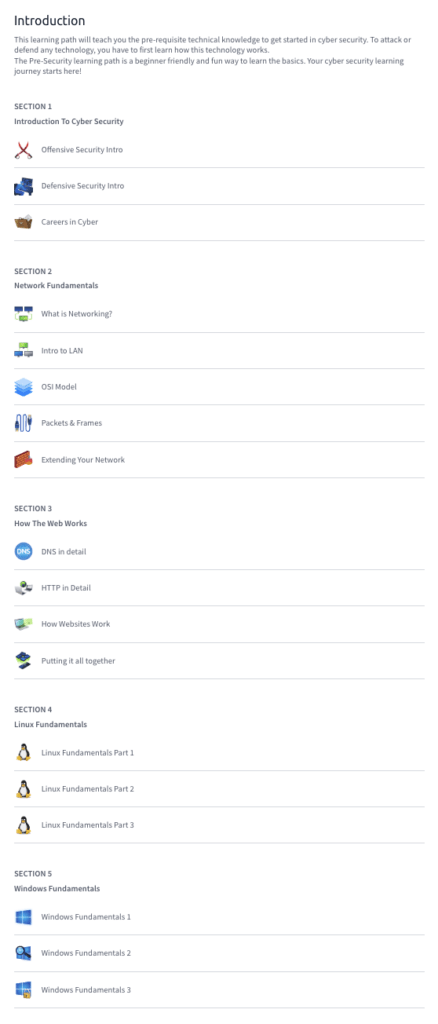
So after completing the Introduction to Security certificate, this was up next. I’ll be going over everything I learned in this blog about the Pre-Security course on TryHackMe. This course was designed as a beginner-friendly introduction to cybersecurity, providing a structured learning path to build a solid foundation.
In this blog, I’ll break down what I learned throughout the course and why it’s a great starting point for anyone looking to break into cybersecurity.
1. Introduction to Cybersecurity
One of the first things I learned was the importance of cybersecurity and its role in protecting digital assets. Key takeaways:
- Understanding Cyber Threats – How cyber attacks work and why security matters.
- Careers in Cybersecurity – Different roles like penetration tester, security analyst, and SOC analyst.
- Fundamental Security Concepts – CIA Triad (Confidentiality, Integrity, Availability).
2. Networking Basics
A strong understanding of networking is crucial in cybersecurity. This section covered:
- IP Addresses & Subnetting – Learning about IPv4, IPv6, and how devices communicate.
- Common Network Protocols – TCP/IP, HTTP, HTTPS, DNS, and how data moves across networks.
- Ports & Services – Understanding different ports (e.g., 22 for SSH, 80 for HTTP) and their functions.
- Network Security Concepts – Firewalls, VPNs, proxies, and IDS/IPS systems.
3. Linux Fundamentals
Since many cybersecurity tools run on Linux, learning the basics was essential. Key lessons:
- Basic Linux Commands –
ls,cd,pwd,cp,mv,rm,nano, etc. - User & File Permissions – Managing access control with
chmod,chown, andls -l. - Process & Service Management – Checking running processes and stopping/starting services.
- Log Analysis – Using Linux logs for forensic investigations.
4. Windows Fundamentals
Windows security is a huge part of cybersecurity. I explored:
- Windows File System & Registry – Learning how the OS stores configurations and system settings.
- Windows Command Line & PowerShell – Using commands like
ipconfig,netstat, andtasklist. - User Management & Permissions – Handling users, groups, and administrator rights.
- Windows Event Logs – How logs can help in security analysis and threat detection.
5. Security Essentials
This section introduced fundamental security principles that every aspiring cybersecurity professional should know:
- Hashing & Encryption – Understanding MD5, SHA-256, and how encryption secures data.
- Social Engineering Attacks – Phishing, pretexting, and how attackers manipulate people.
- Common Malware Types – Viruses, worms, trojans, and ransomware explained.
- Password Security – The importance of strong passwords and multi-factor authentication (MFA).
6. The Basics of Web Security
Since many cyber attacks target web applications, learning web security was critical. Key concepts covered:
- How Websites Work – HTTP requests, responses, and how web applications function.
- Common Web Vulnerabilities – SQL Injection, XSS (Cross-Site Scripting), and CSRF.
- Authentication & Session Management – How weak authentication leads to security flaws.
7. Capture The Flag (CTF) Challenges
One of the coolest parts of the course was solving hands-on cybersecurity challenges. These CTF-style challenges helped me:
- Apply Networking & Linux Skills – Using tools like
nmapandWiresharkto analyze networks. - Think Like an Attacker – Finding vulnerabilities in simulated environments.
- Troubleshoot & Analyze Logs – Investigating security incidents step by step.
Final Thoughts: Why TryHackMe Pre-Security is a Great Starting Point

Completing the TryHackMe Pre-Security Learning Path gave me a solid foundation in cybersecurity. I now have a deeper understanding of networking, Linux, Windows, security fundamentals, and web security. Whether you’re completely new to the field or looking for structured hands-on learning, this course is an excellent starting point.
Next Steps: Now that I have a strong base, I’m excited to dive into more advanced topics like penetration testing, ethical hacking, and digital forensics!
Thanks for reading!!
Jordan Lee